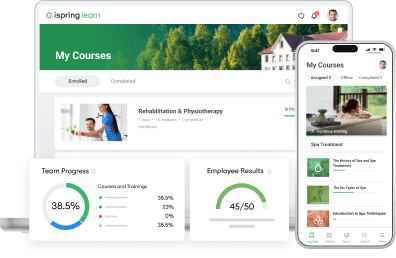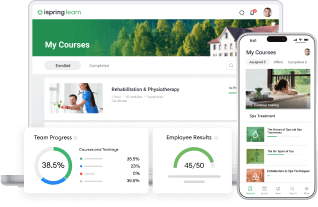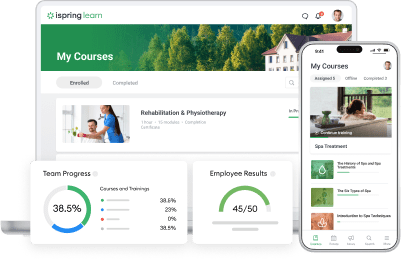Synchronous Learning Simply Put: Definition, Benefits, and Tools

Any learning activity in which all learners are simultaneously participating is called synchronous learning. It’s real-time, highly interactive, and very social.
Even if you don’t know what synchronous learning is yet, you’ve likely come across it at some point. Perhaps you’ve watched a live video on Instagram where you could tap the heart icon to show your appraisal or leave a comment. If that broadcast was teaching you something, say, how to put on makeup, it was actually an example of synchronous learning.
Definition of Synchronous Learning
Synchronous learning is a training activity in which all learners are participating simultaneously. It can happen either online or offline; in both cases, it is highly time-related. You, as a facilitator, need to carefully plan and announce teaching sessions. At the same time, your learners have to book a specific time slot in their schedules to attend, physically or virtually.
What Is Traditional Synchronous Learning Like?
Traditional synchronous learning typically has learners gathering, participating, and getting hands-on experience in a face-to-face setting with an instructor. Two of the most common synchronous formats are: live classroom sessions and on-the-job coaching.
1. Live classroom sessions
Lessons, lectures, and workshops. If you have ever been to school, you know what it can be like. In a business environment, there’s an instructor or a coach instead of a teacher, but everything else is pretty much the same.

The effectiveness of in-person training depends directly on the personality of an instructor.
2. On-the-job coaching
On-the-job coaching is an example of learning by doing, which provides learners with hands-on experience in a work environment and allows them to face the real tasks that they’ll have to deal with in their job. There’s often no formal instructor since experienced coworkers are assigned to take newbies under their guidance.

A senior employee, or a mentor, helps a newbie perform a specific job right within the workplace.
What Is Synchronous Online Learning Like?
The main difference between online and traditional learning is the setting. With synchronous online learning, instructors and students are in different locations and meet in the virtual environment with the help of computers, mobile devices, and specific software tools. Online sessions can be hosted as a webinar, a web-based class, or a live stream.
3. Web-based classes
This format is almost the same as the classroom training, with the exception that the participants aren’t physically present in the same room. Still, remote teachers and learners can freely interact with each other by asking and answering questions, sharing learning materials and demonstrating how to do various tasks.
To learn how to create and successfully run web-based classes, read our post on virtual classroom training.
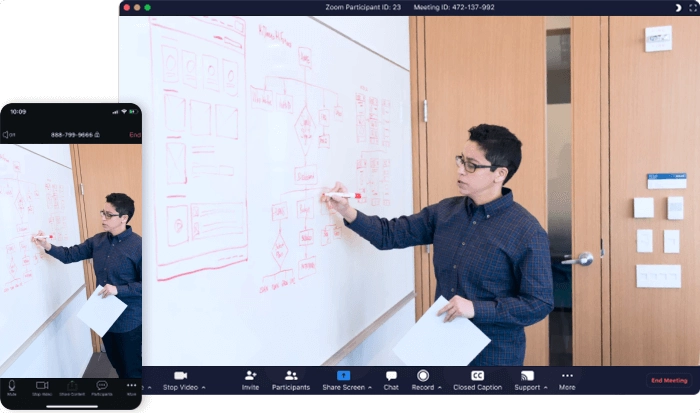
A web meeting in Zoom
5. Webinars
In a typical webinar, only an instructor has the right to speak; learners use text chat to send their questions and give feedback. So, it is often more of a talking-head lecture in which screencasts, slides, polls, and chat feedback might be included.
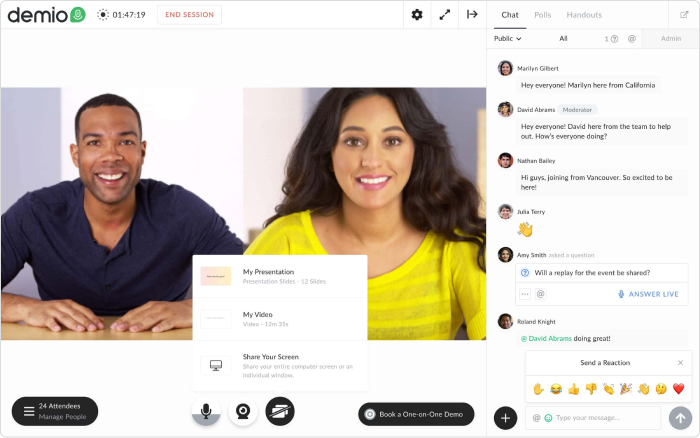
A webinar session
6. Live streams
This is the most informal approach of this list, since learning occurs outside of class time and enters the arena where people communicate and have fun – social media. Think of Facebook Live, Instagram Stories, YouTube Live streaming, or Twitch. With the help of these services, learners can watch experts doing their job in real-time. And not only watch but also comment, like, or even donate some money.
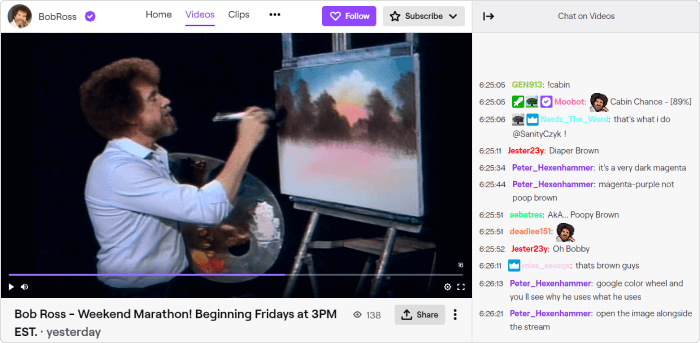
Bob Ross, an artist with the #1 most-watched art channel on Twitch, has over 2,000 viewers of his weekend art marathons
You’ll need some software tools to conduct synchronous online training. Depending on the format you choose, these could be:
- A learning management system that has a web-meeting feature (i.e., iSpring Learn LMS with its Zoom integration)
- A group video chat software (i.e., Skype)
- A video conferencing platform (e.g., Zoom, GoToMeeting)
- A webinar platform (e.g., GoToWebinar, WebinarNinja)
- A virtual classroom software (e.g., WizIQ, VEDAMO)
Advantages of Synchronous Learning
The power of synchronous learning includes two key aspects:
1. A better feedback loop
Being present here and now, you can share feedback on how learners are doing in real-time. This allows them to correct mistakes right on the spot and get positive reinforcement of the desired behavior, performance, or using a new skill. Plus, this channel works two ways, so an instructor can also get feedback from the learners and adapt the presentation or provide additional information if there are questions.
2. Better chances to build a community
Discussions and collaboration are the drivers of building a healthy community with strong instructor-student and student-student relationships. An additional bonus of synchronous learning is that it helps learners avoid the feeling of isolation that may occur in asynchronous activities.
3. Learning from anywhere
This is, of course, relevant only for online synchronous learning. Learners and instructors can meet in a single virtual environment regardless of where they are; all that they need is a computer or even a mobile device with Internet access. This is very handy for learners who are unable to travel to a school or campus daily and for employees who work remotely.
These three benefits provide learners higher engagement, resulting in better results.
The Pitfalls of Synchronous Learning
While the benefits of synchronous learning are clear and beyond all question, there are a few aspects that need thorough consideration:
1. It’s time-consuming
Unlike asynchronous training where you can record a video lecture once and then rest on your laurels with a live event, you need to be online (or in class) at a certain time. And given the highly interactive nature of live classes, each of them is different, even if your material is the same. This also results in spending more time on self-preparation.
2. It’s often more expensive (than asynchronous learning)
The natural sequence of the previous point. The more time you spend on conducting a course, the more expensive it is. As for in-person sessions, they require much more effort and resources to facilitate them, let alone adding travel and accommodation expenditures if there’s a need to teach remote groups.
3. It needs accurate scheduling
Perhaps, the most serious challenge in training employees is finding an empty slot in their busy schedules, so everyone can attend. If overlooked, there’s a risk that there will be just a few learners present.
Conclusion
Engaging with learners and addressing their questions, comments, and feedback is a never-ending but critical endeavor for effective learning. This is what traditional and online synchronous learning can help you deal with.
But who said you must stick to purely synchronous learning? You can easily combine approaches by recording and uploading your streams to a learning management system. With an LMS, not only will the learners who have missed the class be able to watch it, but you’ll lighten your workload by getting the maximum out of past successful learning sessions and combine them into learning tracks.
